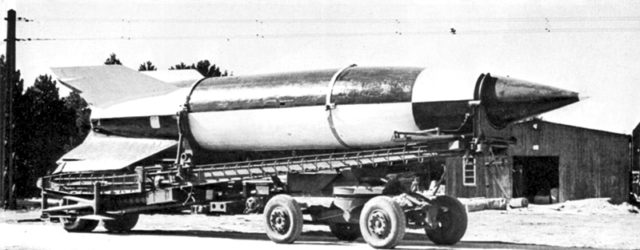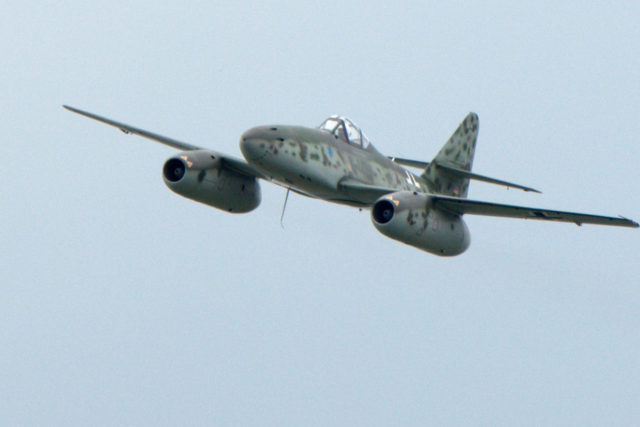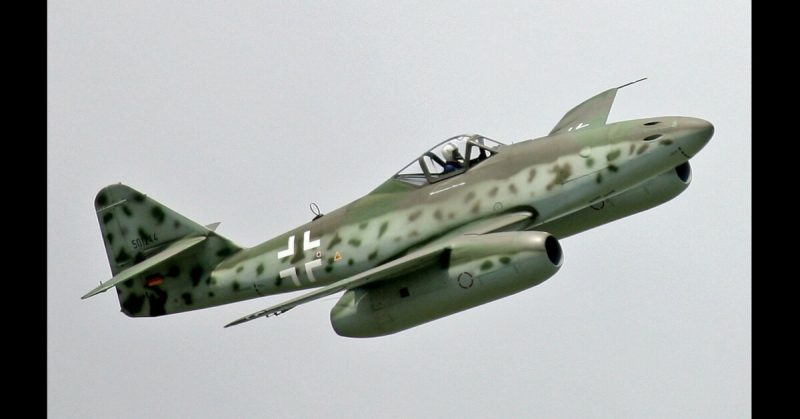Hitler and the Nazis were fans of new weapons technology. Germany had been at the forefront of aerial warfare and other important technologies in WWI. The terms of the armistice at the end of the war had forced German arms manufacturers to find ingenious new approaches. They needed to make effective weapons within the set limits.
When WWII began, the gloves were off. German engineers worked hard to develop new technologies, both at home and in occupied territories, such as the underground bases and wide test fields of Poland.
One of the greatest areas of innovation was rocketry. It led to three ingenious types of weapon, one of which filled the Allies with terror and one which was never used.
Missile Attacks
The V2 rocket and its predecessor the V1 had the potential to transform WWII. The world’s first long-range unmanned missiles, they were a potent weapon in the German arsenal.
Building on ideas first suggested in 1936, the V1 (V for Vengeance) was developed in the Peenemünde research base by the Luftwaffe. It was the first mass produced aircraft to use a pulse jet engine which gave it its distinctive buzzing sound. It had a metal fuselage and wooden wings.

The V1 could reach Britain from northern France. A week after the D-Day landings in June 1944, the first V1s were launched in revenge attacks against southeast England. Within months, the Allies overran the launch sites, and the V1s were no longer a threat to England.
In the meantime, the V2 had come into use. The first long-range guided ballistic missile, it was closer in appearance to a rocket, lacking the V1’s wings. Using a liquid propellant rocket, it was the first man-made object to cross into space. It’s extra range meant it could target London long after the V1s had stopped.
The arrival of the rockets came as a great shock to most people, but the British military already had some idea of what was coming. Thanks to the intelligence gathering of resistance fighters, aerial reconnaissance, and a disgruntled German scientist, they knew about German rocketry. Targeted bombing raids by the British had held back both the development and the launch of the rockets. They arrived too late to turn the tide of war.
The V1 and V2 rockets altered the stakes for the Allies on the continent. Capturing or destroying the launch sites and so stopping the attacks on London affected strategic choices about how and where to advance.
Jet Planes
Many countries were working on jet aircraft during WWII. The first widely publicized flight was by the Italians in 1940. By the end of the war Britain, Japan, and the United States had all put jet aircraft into combat. Germany, however, was the first.
On August 27, 1939, Germany conducted its first test flight of a Heinkel He 178, the first practical jet aircraft. Unlike the Italians, the Germans did not make a big public display of their achievement. Instead, they continued their program of secretive design and research.
On April 19, 1944, the Messerschmitt Me 262 entered service. It was the first jet-powered combat plane and the fastest aircraft of the war. It was also more heavily armed than any allied fighter. It was used in a variety of roles, including as a fighter, a light bomber, a reconnaissance plane, and an experimental night fighter.
The Me 262 was a very effective weapon, and its pilots racked up 542 kills. However, technological problems and political interference held back its launch for most of the war and its pioneering engines were sometimes unreliable.

The Allies dominated in the air and within months would be advancing across Europe. While the Messerschmitts were a match for any opponent in the skies, fuel shortages made it increasingly difficult to keep them aloft. By bombing airfields, the Allies destroyed Me 262s without the danger of having them fight back.
It was one of the best planes of the war, but it came too late to save the Reich from disaster.
Rocket Packs
One of the strangest creations was the Himmelstürmer flight pack. In development by 1944, it had two jet engines. The main one was strapped to the wearer’s back, providing forward and upward propulsion. The other was directed using handgrips, providing direction and stability.
Unlike other jets under development, the Himmelstürmer pack could not rely on forwarding movement to push oxygen into its intake. Instead, the oxygen had to be force fed from a tank.
It was a development from 1918 when elite Stormtroopers equipped with hand grenades and light machine guns had broken through Allied trenches in lightning assaults. The idea was to do the same from the air.
The range of these first jet packs was limited. Test flights covered distances of 50 to 70 meters. Fuel limitations meant long trips could not be made and the packs had to be switched off immediately on landing. They would perhaps have gotten their wearers across barbed wire, minefields, and tree cover, but would not have allowed them to fight in the skies.
The Himmelstürmer never saw service. By the time it reached the test phase, the war was turning against Germany. Resources were running low, and every available soldier was being sent to the front.
American forces seized a prototype of the jet pack and took it back to Bell Labs. No-one was willing to risk flying the machine, but like the rest of Germany rocket science, it became part of wider research that eventually put men on the moon.
Sources:
Ralph Bennett (1999), Behind the Battle: Intelligence in the War with Germany 1939-1945.
David Rooney (1999), Military Mavericks: Extraordinary Men of Battle.
